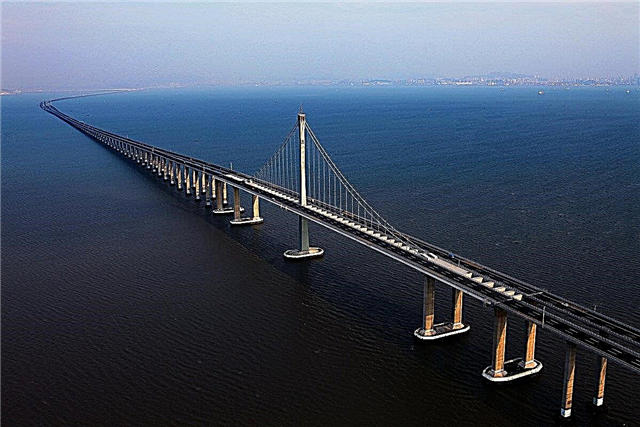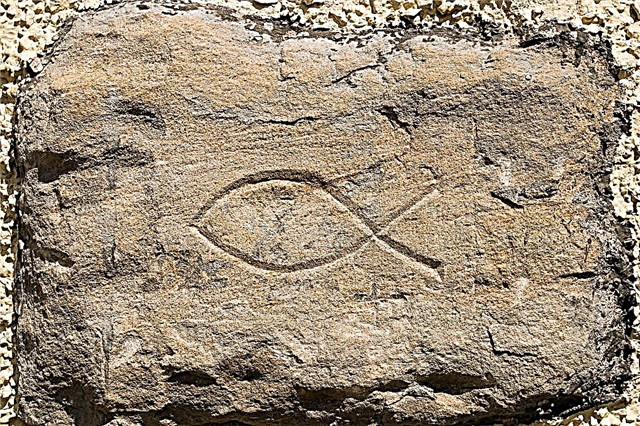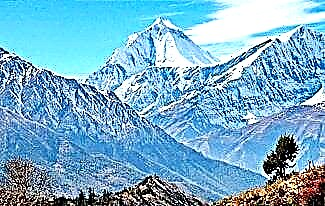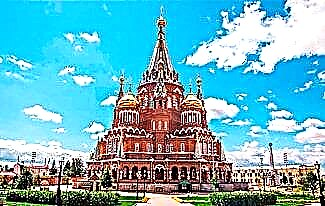Uranus is rightfully considered the seventh planet in the solar system. In addition, life is impossible on it for organisms such as humans. Scientists are trying to explore the planet to get the most out of it for the Earth. Next, we suggest reading more interesting and exciting facts about the planet Uranus.

1. Uranium was discovered 3 times.
2. This planet is considered the 7th in the Solar System.
3. One year on Uranus is equivalent to 84 years on Earth.
4. The atmosphere of Uranus is recognized as the coldest and equates to -224 ° C.
5. The diameter of the planet is almost 50,000 km.
6. The tilt axis of Uranus is equated to 98 ° C and it seems that it is as if lying on its side.
7. Uranus is the 3rd mass planet in the solar system.
8. A day on the planet Uranus lasts about 17 hours.
9. Uranus is a blue planet.
10. Today Uranus has 27 satellites in total.
11. The density of Uranus is equal to 1.27 g / cm³. Moreover, it is in 2nd place in terms of density. (on the first - Saturn)
12. Clouds on the planet Uranus can be seen through infrared waves.
13. Many of the clouds on the planet can only exist for a few hours.
14. The wind speed on the rings reaches - 250m / s.
15. Wind speed in middle latitudes reaches 150 m / s.
16. The mass of all the moons of Uranus is less than half of Triton (the largest moon of Neptune) - the largest of its kind in the solar system.
17. The largest satellite of Uranus was the satellite Titania.
18. Uranus was discovered after the invention of the telescope.
19. For the first time, after the discovery of the planet, they wanted to name it in honor of King George III of England, but the name did not catch on.
20. Every space lover will be able to admire Uranus, but only with very dark skies and good weather conditions.
21. The only spacecraft to visit Uranus is Voyager 2 in 1986.
22. The atmosphere of this planet is composed of hydrogen, helium and methane.
23. An interesting fact is that all the moons of Uranus were named after Shakespeare and Pope.
24. Uranus, like Venus, rotates clockwise than the rest of the planets of the solar system. This is called a retrograde orbit.
25. Herschel, was the last to discover Uranus. Moreover, he just realized that this is a planet, not a star. This event took place in 1781.
26. Uranus received its final name from the German astronomer Johann Bode.
27. The planet Uranus got its name in honor of the Ancient Greek God of the Sky.
28. As a result of the presence of methane in the planet's atmosphere, its color has a blue-green tint.
29. Uranium is more than 83% hydrogen. The planet also contains helium 15 ± 3%, methane 2.3%.
30. Scientists believe that Uranus began to rotate on its side after a collision with a larger cosmic body.

31. It is worth noting that while on one part of the planet it is summer, and the burning rays of the sun hit each pole, the other part of the planet is subject to severe winter in darkness.
32. The magnetic field of one side of Uranus exceeds the other by more than 10 times.
33. The polar compression index reaches - 0.02293 gauss.
34. The equatorial radius of the planet is 25559 km.
35. The polar radius reaches 24973 km.
36. The total surface area of Uranus is 8.1156 * 109 km.
37. The volume is 6.833 * 1013 km2.
38. According to the data provided by Canadian astronomers, the mass of Uranus is 8.6832 · 1025 kg.
39. In relation to the core of the planet Uranus, the gravity indicators have less weight than on Earth.
40. The average density of Uranus is 1.27 g / cm3.
41. Acceleration of free fall at the equator of Uranus has an indicator of 8.87 m / s2.
42. The second space velocity is 21.3 km / s.
43. Astronomers have found that the equatorial rotation speed is 2.59 km / s.
44. Uranus is capable of making a complete revolution around its axis in 17 hours 14 minutes.
45. The indicator of right ascension of the North Pole is 17 hours 9 minutes 15 seconds.
46. The declination of the North Pole is -15.175 °.
47. Scientists have found that the angular diameter of Uranus is 3.3 ”- 4.1.
48. Hydrogen is most of all in the composition of the planet. Uranium is 82.5% composed of it.
49. The core of the planet consists of stone.
50. The planet's mantle (the layer between the core and crust) weighs 80,124. It also equals roughly 13.5 Earth masses. Consists mainly of water, ammonia and methane.
51. The first and largest moons of Uranus discovered by scientists were Oberton and Titania.
52. The moons Ariel and Umbriel were discovered by William Lassell.
53. The Miranda satellite was discovered almost 100 years later in 1948.
54. The satellites of Uranus have the most beautiful names - Juliet, Pak, Cordelia, Ophelia, Bianca, Desdemona, Portia, Rosalind, Belinda and Cressida.
55. The satellites are predominantly composed of ice and rock in a ratio of 50/50%.
56. For 42 years there is no sun at the poles, sunlight does not reach the surface of Uranus.
57. Gigantic storms can be observed on the surface of Uranus. Their area is commensurate with the area of North America.
58. In 1986, Uranus was nicknamed "The most boring planet in the universe."
59. Uranus consists of two systems of rings.
60. The total number of rings of Uranus is 13.
61. The brightest ring is Epslon.
62. The discovery of the Uranus Ring System was confirmed as recently as 1977.
63. The first mention of Uranus was made by William Herschel in 1789.
64. Many scientists believe that the rings of Uranus are very young. This is evidenced by their color, because they are very dark and not wide.
65. The only theory about the appearance of rings around the planet is that, possibly, in the past it was a satellite of the planet, which collapsed from a collision with a celestial body.
66. Voyager-2 - a spacecraft that took off in 1977, reached its target only in 1986. In January 1986, the spacecraft was at its closest approach to uranium - 81,500 km. Then he transmitted thousands of pictures of the planet to the earth, in which 2 new rings of Uranus were discovered.
67. The next flight to Uranus is planned for 2020.
68. The outer ring of Uranus is blue, followed by the red ring, while the rest of the rings are gray.
69. Uranus by its mass exceeds the Earth by almost 15 times.
70. The largest moons of the planet Uranus are Ariel, Titania and Umbriel.
71. Uranus can be seen in August in the constellation Aquarius.
72. It takes 3 hours for the sun's rays to reach Uranus.
73. Oberon is located farthest from Uranus.
74. Miranda is considered the smallest satellite of Uranus.
75. Uranus is considered a planet with a cold heart. After all, the temperature of its core is much lower than that of other planets.
76. Uranus has 4 magnetic poles. Moreover, 2 of them are major, and 2 are minor.
77. The nearest satellite from Uranus is located at a distance of 130,000 km.
78. In astrology, Uranus is considered the ruler of the sign of Aquarius.
79. Planet Uranus was chosen as the action of the famous movie "Journey to the 7th Planet".
80. One of the main mysteries of the planet is low heat transfer. Indeed, in general, all large planets give off 2.5 times more heat than they receive from the Sun.
81. In 2004, weather changes occurred on Uranus. It was then that wind speeds up to 229 m / s and a constant thunderstorm were recorded. This phenomenon has been nicknamed "the 4th of July fireworks".
82. The main rings of Uranus have the following names - U2R, Alpha, Beta, Eta, 6,5,4, Gamma, and Delta.
83. In 2030, Summer will be observed in the northern hemisphere of Uranus and Winter in the southern hemisphere. This phenomenon was last observed in 1985.
84. An interesting fact is also the successive discovery of the last 3 satellites. In the summer of 2003, American astronomers Showalter and Lieser discovered the moons Mab and Cupid, and 4 days later their colleagues Shepard and Jewet made a new discovery - the satellite Margarita.
85. In New Time, Uranus became the first of the discovered planets.
86. Today, the mention of Uranus, like other planets, is found in many books and cartoons.
87. Most of the satellites were discovered during Voyager 2's 1986 research.
88. The rings of Uranus are mainly composed of dust and debris.
89. Uranus is the only planet whose name does not come from Roman mythology.
90. Uranus is located on the border of light and night.
91. This planet is almost 2 times farther from the Sun than its neighbor Saturn.
92. Scientists learned about the composition and color of the rings only in 2006.
93. To find Uranus in the sky, first of all, you need to find the star "Delta Pisces", and 6 ° from it there is a cold planet.
94. It is believed that the outer ring of Uranus is blue because of the ice that it contains.
95. To study at least some details of the Uranus disk, you need a telescope with a 250 mm objective.
96. Many astronomers believe that the moons of Uranus are parts and fragments of the material from which the planet was formed.
97. It's no secret that Uranus is one of the giants of the Solar System.
98. The average distance from the Sun to Uranus is 19.8 astronomical units.
99. Today Uranus is considered the most unexplored planet
100. Leland Joseph proposed to name the planet after its discoverer - Herschel.









